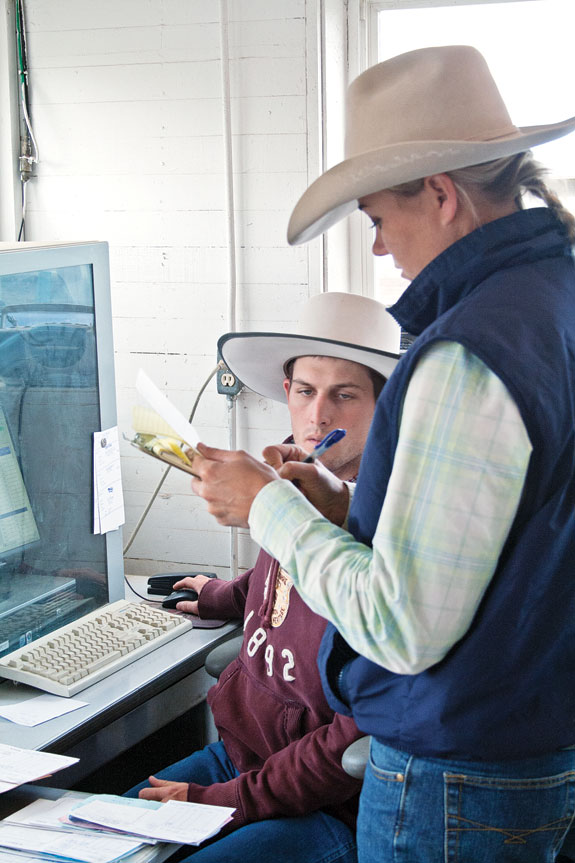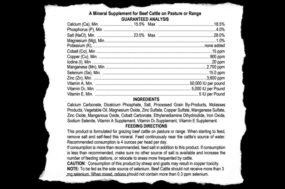How many head made it to the end of the drive and market price per head were important figures to the trail boss when the railhead town was on the horizon.
These figures may seem simple but, for those drovers, it was the hard and fast bottom line.
Finding the cowhand that could record these figures was sometimes a challenge, but even the crudest numbers or forms of manipulating those numbers started what we call record-keeping.
These figures have transformed themselves over the years to end up with some fancy economic name but the principle is the same: Ranchers must know the numbers and manipulate data for the good of the operation.
“Producers need to decide exactly what they want to accomplish and that will help them decide what information is important to the operation.
Record systems can be as complicated or as simple as cattlemen want them to be,” says Curt Lacy, a University of Georgia extension economist.

Keeping it simple
The sophistication of the record-keeping system will also depend on what type of data the operation finds useful. Simple systems keep track of things like expenses, inventory and cattle marketed. More complicated computer-driven systems will often expand on this type of data to provide more detailed analysis.
“A simple record-keeping system can start with a spiral notebook, No. 2 pencil, calculator and 12 envelopes. Cattlemen can keep track of receipts and expenses in an envelope for each month.
The inventory and what you market are important pieces of information,” Lacy says. “Producers can certainly take advantage of technology and some will end up investing in a program to help keep track of their records.
Start with a Schedule F for taxes and work back to what’s important for your operation. Decide what production data will help you become a better manager and add value to your calf crop.”
“Our program allows producers to be as simplistic or as comprehensive as they choose. Most find through the electronic system, they are keeping more records,” says Kathie Williams, manager of Global Livestock Management Systems, which markets CattlePro software programs.
More and more ranchers are reaching for technology to help manage data. Tailoring the record-keeping system to management style will help cattlemen better manage data.
Computer-generated reports help cattlemen become more efficient with allotted time and should help decide what information is important.
“We have customers that use almost everything our program has to offer. We can customize a program to a specific operation,” Williams says. “Region-specific data is important to certain operations.
We have producers who want to add things like hair coat or disposition for each animal. Reports can be generated to manage keep/cull decisions, and weights and measures are readily visible for each animal.”
Worth the investment
“When you invest in a software program, producers need to be sure that’s the program that will work for them and it’s worth the investment.
Software programs allow producers to manipulate the data,” Lacy says. “If a producer tries to collect every piece of data, they are going to become frustrated.
It’s a mess trying to sort through it all and figure out what’s useful information. Define what works for the operation to eliminate the headaches.”
Getting started with this type of system requires some very basic hardware. Utilizing what technology has to offer will help simplify data entry once the program is up and running. Notebooks, laptops or tag readers have become a vital part of certain operations.
“A decent laptop, some type of Internet connection and a software package for record-keeping will get most started,” Lacy says. “Knowing the number of acres you have in pasture or number of acres of hay is important to some operations.
If winter annuals are an option, most need to have a base number of acres to budget cash flow for things like fertilizer or how many acres need to be planted. A handheld GPS will figure all that out in a short amount of time.”
“With our system, it’s a simple process to get started and a lot less time-consuming than people think.
For some operations cattle may not be the only enterprise and a computer-generated system can help relieve some of the record-keeping stress,” Williams says.
“Any computer will work. It’s just a matter of preference for most. A lot of our veteran users like iPads or inexpensive notebooks that fit in a saddle bag or easily in the console of a truck. Smartphones sometimes don’t work very well because of the remote location most ranchers operate in.”
Accurate records can help cattlemen become better marketers. Utilizing the data collected on a daily basis sometimes will enhance market value if it can be communicated.
“In today’s market environment there are several ways to add value. Things like source and age verification or documenting raising and handling practices are opening marketing doors,” Lacy says.
“These records have to be in an accessible format for the producer and end user. Records can help give the buyer the information they are looking for, especially if you have a load lot.”
Recording patterns and habits
Good records can only help the operation if they are used and kept current. Volatile markets, whether it is the price per pound, feed prices or other input costs, keep the environment changing.
Computer programs cannot generate statements alone; it’s not automatic and producers must take charge of the system to make it useful to the operation.
“If you don’t keep up with record-keeping it’s not doing you any good. A lot of producers try to update daily and if they can’t do that it’s at least every week,” Williams says. “Taking tools to the pasture allows producers to enter data and it’s automatically updated in the system.”
“Find a guideline to get started and whittle down data to what you need. There is no point in keeping detailed records unless you are going to use them,” Lacy says.
“If you haven’t ever kept detailed records to begin with, buying a computer and some software isn’t magically going to help gather data. We have to do bookwork more often than a rainy day. I encourage producers to set aside time at least once a week to get caught up on the books.”
Records will not automatically make the operation profitable overnight, but the right information could help establish breakevens or add value to the product.
Valuable data to help production and financial decisions can be generated with the right amount of effort. Utilizing some sort of record-keeping system helps producers know more about the operation, and most know there is power in information.
“Producers have to be able to manipulate the data they collect; otherwise it’s useless. Decide what you want to do and how to collect, record and organize useful information,” Lacy says. “There are a multitude of ways records can bring value to an operation.” ![]()
Clifford Mitchell is a freelance writer based in Oklahoma.
PHOTO
Computer-generated reports help cattlemen become more efficient with allotted time and should help decide key priorities on the operation. Photo courtesy of Progressive Cattleman staff.






